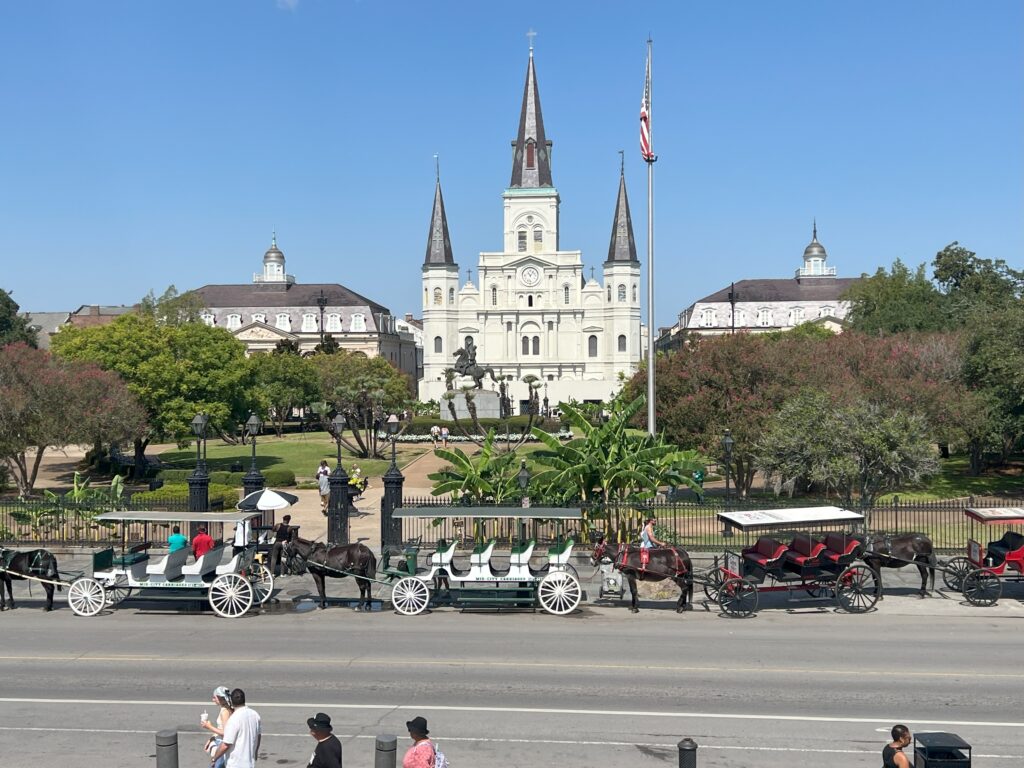
Hotel Montelione, Royal Street, New Orleans – what a welcome change from The Monmouth Inn in Natchez! Everything is right about this hotel – the rooms are ready for us even though we arrive early; the staff are pleasant; the rooms are good; it’s in a perfect position in the French Quarter; and it’s even got a lovely pool and bar up on the roof.
It’s not quite the expected Creole cuisine, but we end up having lunch in the Athenian Greek restaurant, just round the corner. The Athenian is open when other restaurants have packed up, they do genuine Saganaki, Greek salad, and the best Orange Pie for afters that we’ve ever tasted. Then it’s time to work off the lunch by lounging and drinking by that pool on the hotel roof.
The hotel has a rather eccentric lift (elevator, as they call it here) which won’t be persuaded to stop at certain floors. One of the floors is ours – floor ten – and on the way down from the pool we have to take the lift to floor eight and then walk back up two flights. (We still hadn’t worked out the lift’s unconventional rulebook by the time we were leaving, three days later.)
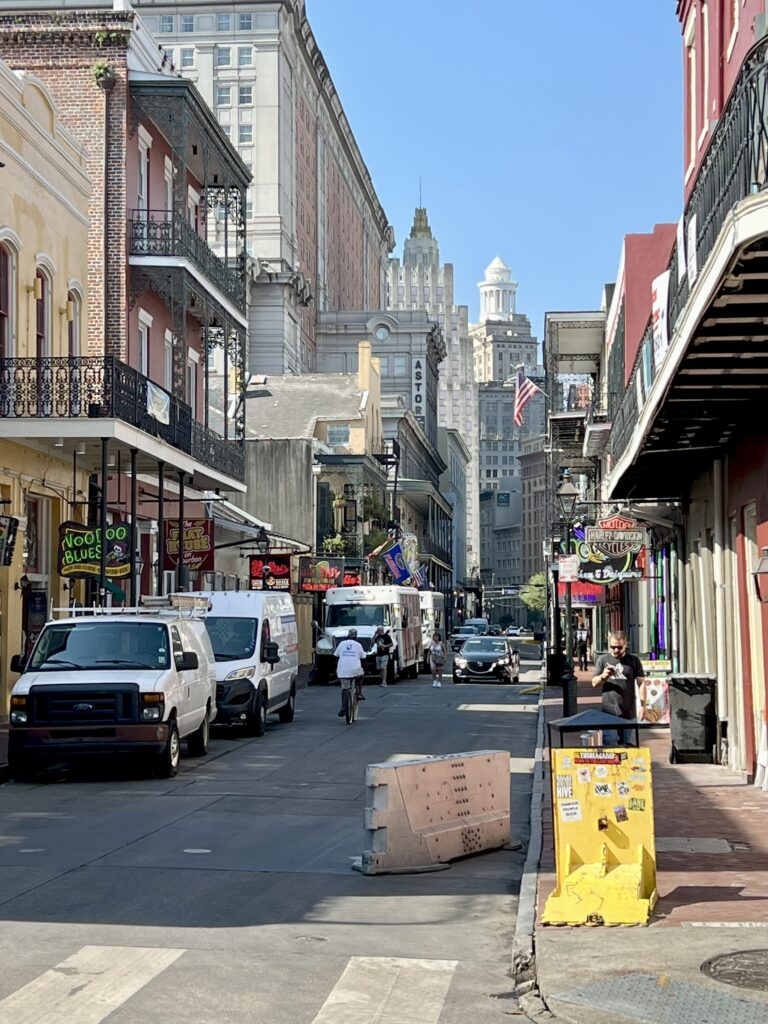
In the evening we eat at Brennans Restaurant on Royal street ….”For nearly seven decades, charming the palates and hearts of patrons with its splendid ambiance, impeccable service, and authentic Creole cuisine.” Yes it’s good and I can personally vouch for the blackened red fish with cabbage and curry sauce. Unfortunately Maggie is suffering from a bad cold which curtails her enjoyment of the evening, and it’s early to bed.
It’s the following morning and we are visiting the Museum. It’s a first for us, we haven’t been to a museum of prostitution before. It’s the ‘Storyville Museum’ – sounds like a museum of children’s books doesn’t it? But no, it’s the story of New Orleans’ bawdy past.
It all started innocently enough. The French guy who established New Orleans in 1718 needed wives for his men so he asks Paris to send some potential wives from France. But they send the wrong kind of girls. The men enjoy their company but don’t want to marry them.
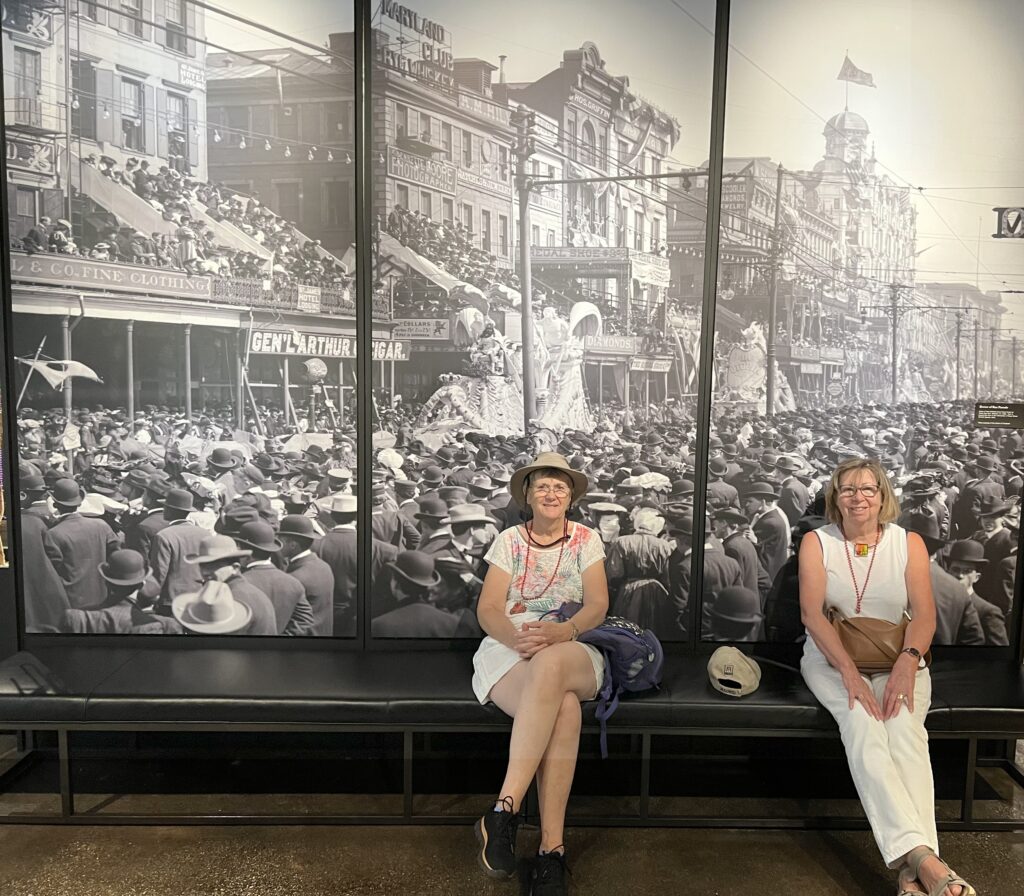
Later, as the city is growing, there develops a steady flow of goods transported down the Mississippi river. The goods were brought down on wooden barges by rough and ready men known as Kaintucks from the upper Mississippi. These flatboats can’t navigate back up the river so the Kaintucks are faced with a long walk home – 30 days or more. They are paid when the cargo is unloaded and want some relaxation before heading home. The barges are broken up and used to contribute to the city’s building materials. The Kaintucks are flush with cash and use it to contribute to the economy of the city’s brothels.

Remember ‘The House of the Rising Sun’?
But it’s all going a bit over the top, so in 1897 councilman Sidney Story sponsors a law to make prostitution illegal in New Orleans except for in two specific areas. The main area, just outside the French quarter, becomes known as ‘Storyville’. So that’s where the name comes from, and it seems ironic that Sidney – the guy who tried to tidy it all up – has his name forever associated with the red-light district. And it’s the largest and most ostentatious red-light district the country has ever seen. I wonder if Sidney would be OK with that?
It took a world war to eventually bring it to an end. The US army set themselves up in the city and closed down the brothels to ensure their men stayed tip-top healthy and ready for duty. A walk along Bourbon Street at night, however, suggests that today there’s still a whole variety of shady pleasures to be discovered in the city.
In the evening we have an organised city jazz tour, meeting at 5pm in the Louis Armstrong park, at the north boundary of the French Quarter on North Rampart Street. Kristi, our tour guide, is brilliant – she’s a local girl and passionate about the New Orleans story. I wondered why we were meeting in a park for a jazz tour, but it soon becomes clear. So much of the character and history of this city is bound up with the slave trade.
Louis XIV issued a decree called ‘Le Code Noir’ defining the rules about slavery in the French colonies. A key article of the code was that slaves must be baptised and instructed in the Roman Catholic faith. On the positive side, therefore, they had to be given Sunday as a day of rest and they gathered in Congo Square, now part of the park, to socialise, play music, dance, and sing.
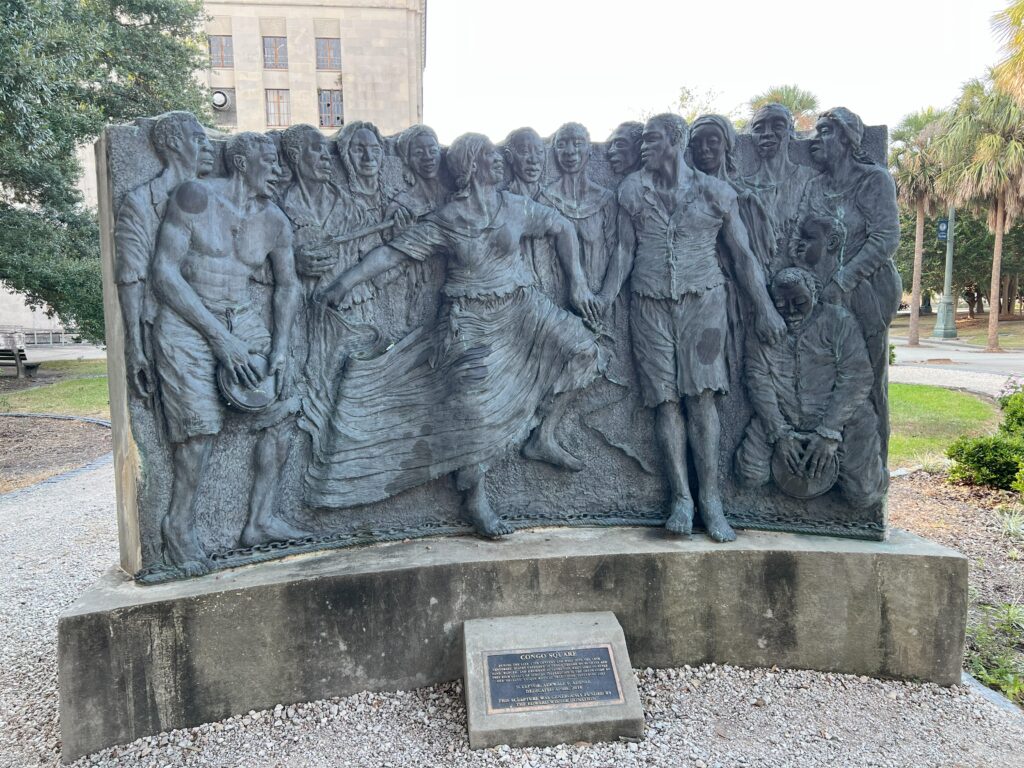
To this culture add the indigenous tribes, a variety of Caribbeans, immigrants from many parts of Europe, and the result is one of the greatest melting pots of cultures, music, food, and, well, virtually everything that this city is today.
Music, especially, is in the blood of the people here. It’s part of their make-up, their DNA – it comes naturally. In most cases the musicians were not even formally trained – they picked it up, learned it on the street, and made it up as they went along. And that now has the posh name ‘improvisation’ – at the heart of jazz. You get the feeling that everyone here is a musician of one form or another.
Not so well known, (and probably disputed by Memphis), New Orleans also claims to be the birthplace of Rock and Roll. Kristi explains as we pass number 838, North Rampart Street that this tiny building was once a recording studio started by Cosimo Matassa, an 18-year old University dropout who knew nothing about recording music. But he learned fast and went on to record hits by Fats Domino, Little Richard, Bobby Charles (“See you later alligator”), and more. Consequently the site is designated as a historic landmark – although casual passers-by might be puzzled because it’s now a launderette.
Then it’s down to Bourbon street and ‘Fritzel’s European Jazz Pub’. This pub is so good we return the following evening, so I’ll tell you about it then. After Fritzel’s we move on to Mahogony Jazz Hall – specialities Absinthe and Burlesque – and another great, friendly and intimate live music bar. Here we say goodbye to Kristi – she has to collect her daughter from dancing class.
If you ever visit New Orleans be sure to join one of Ktristi’s tours. (Urban Adventures) – a very enjoyable way of uncovering the jazz scene and its roots in the city.
When we are done with the jazz bars it’s late night, restaurants have closed, and we are hungry. The only place we can find is one of those late night pizza joints serving slices of pizza served on paper plates, and eaten on our feet amongst the last of the late-night people. When I pay I’m given an option of adding on an 18% tip or a 20% tip. To ‘serve’ me the guy has to separate a slice of pizza from the pizza round, place it on a paper plate, and hand it to me over the counter. He does all this standing in one place – doesn’t even need to move about. It’s another example of tipping in the USA becoming an entitlement, nothing to do with service anymore. Crazy.
But the slice of pizza is unexpectedly good and we go to bed happy.
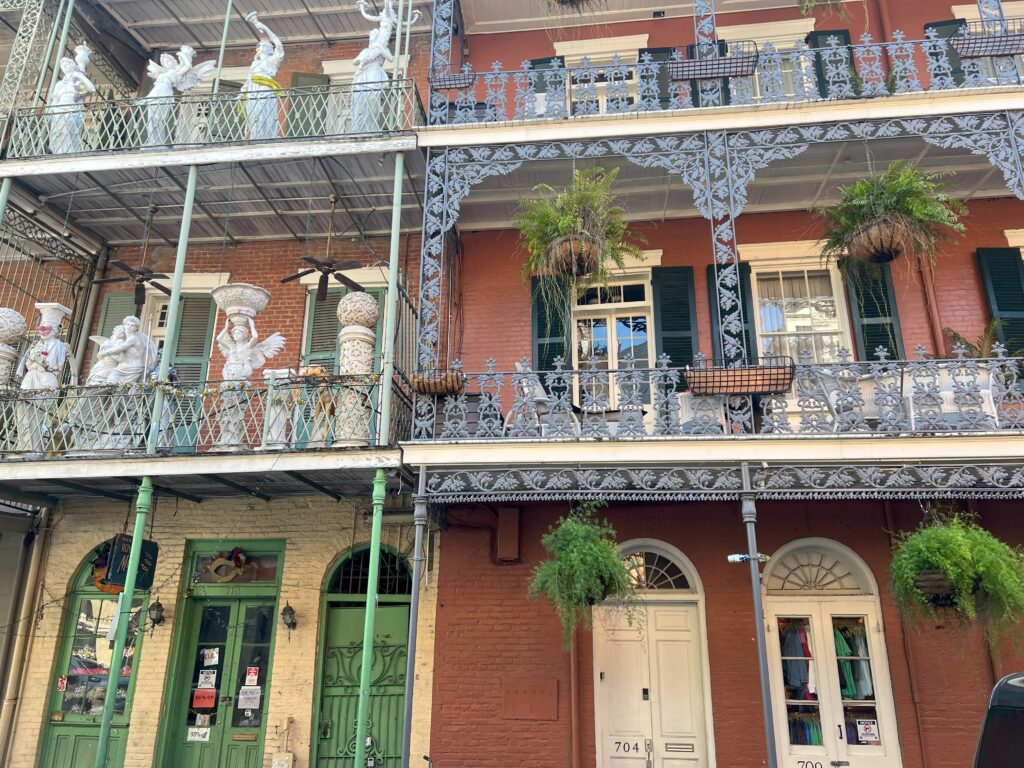
The next morning, while Maggie and Richard are off on their alligator swamp tour, we take a walk up to Frenchman Street – where we were first introduced to new Orleans jazz some years ago – and back via the French Market. We are relieved to find that Maggie and Richard have returned from their close encounters with alligators with all limbs intact so we lunch together on the hotel roof by the pool. Then it’s an early evening pork chop at Cochon restaurant in the Warehouse District, and back to Fritzels jazz bar for the night.
Fritzel’s is a cosy laid-back bar where we can enjoy great live music from the band just a few feet away and a regular supply of beer brought to us on demand. The place soon fills up so there’s not an empty seat in the house. The band – as well as being great musicians – are also great entertainers. Each member has his party-piece.
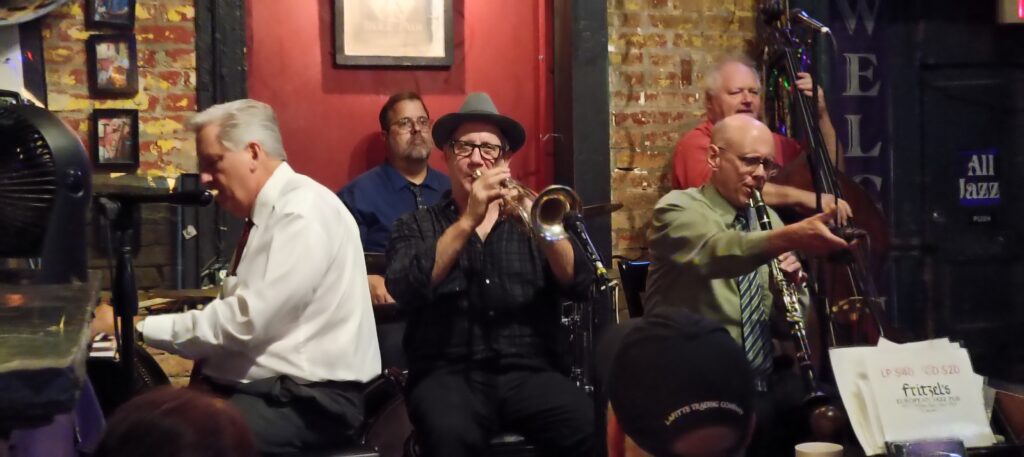
There’s John Royen on piano with unlit cigar continually hanging from his mouth, quick to make sharp comments on the other members, Chris Sharkey who likes to do a celebratory spin of his double bass after each number, and the surprising Tom Fischer who looks like a small-time company accountant but can hang on to a note on his clarinet seemingly forever. As a finale, in mid-note he walks slowly over to the bar, holding the note the whole way, gets himself a beer, and then leisurely rejoins the band before finally letting go of the note.
It’s a great evening and it’s not over yet – there’s more energising music still playing in the hotel bar when we get back.
It’s the following morning, our last day in New Orleans, and we join Maggie and Richard for breakfast at the Sinestra hotel. Some more time spent relaxing on the roof – now our default GoTo place – and mid-afternoon we return to the Athenian for a late lunch and a further fix of the orange pie with oozo’d apple juice before leaving for the airport.
This was our third visit to New Orleans and on each visit we’ve discovered lots of new things and re-enjoyed others. I can very well imagine repeating this formula again in the future.